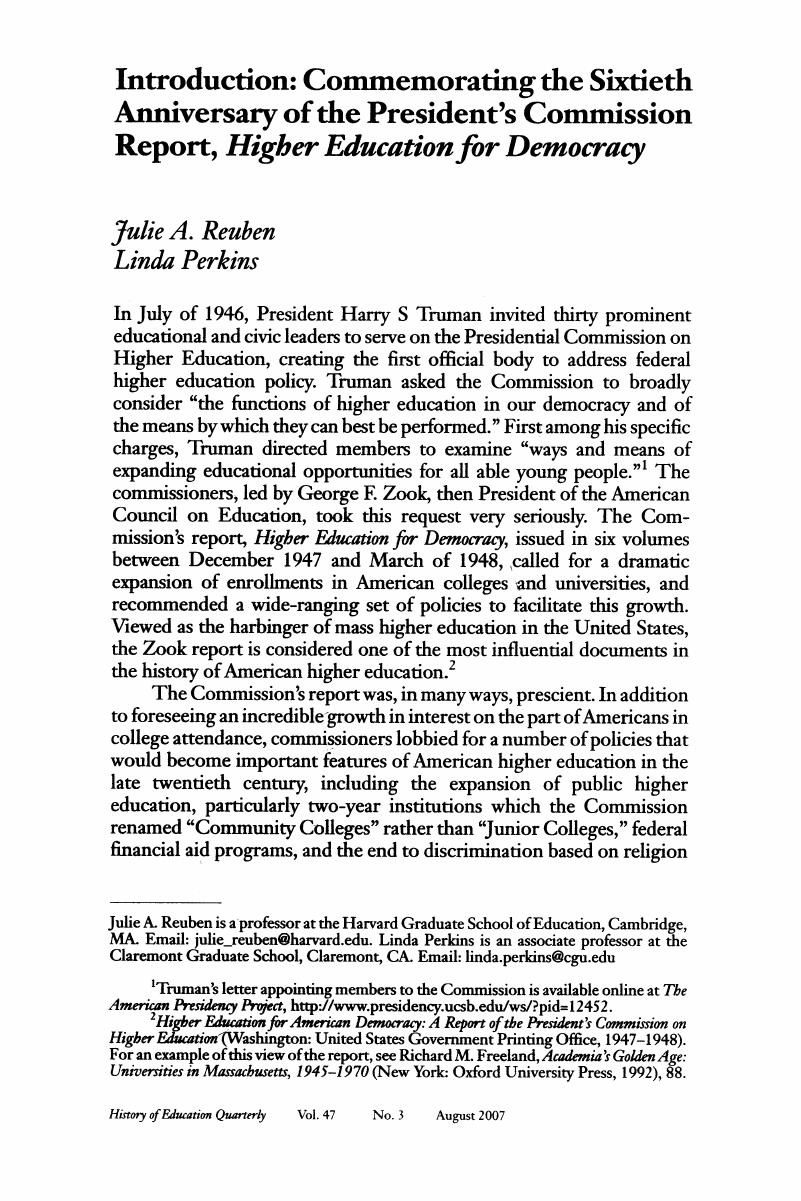Published online by Cambridge University Press: 24 February 2017

1 Truman's letter appointing members to the Commission is available online at The American Presidency Project, http://www.presidency.ucsb.edu/ws/?pid=12452.Google Scholar
2 Higher Education for American Democracy: A Report of the President's Commission on Higher Education (Washington: United States Government Printing Office, 1947-1948). For an example of this view of the report, see Richard M. Freeland, Academia's Golden Age: Universities in Massachusetts, 1945-1970 (New York: Oxford University Press, 1992), 88.Google Scholar
3 For the best overview of the history of access to higher education in the United States and review of scholarship in this area, see Scott Gelber, “Pathways in the Past: Historical Perspectives on Access to Higher Education,” Teachers College Record 109 (2007), online at http://www.tcrecord.org/Content.asp?ContentId=12566.Google Scholar
4 On enrollment before 1860, see Burke, Colin, American Collegiate Populations: A Test of the Tradition View (New York: New York University Press, 1982). For a general overview of institutional change, see John R. Thelin, A History of American Higher Education (Baltimore: Johns Hopkins University Press, 2004).Google Scholar
5 For enrollment information after 1870, see Synder, Thomas D., ed., 120 Years of Education: A Statistical Portrait (Washington: National Center for Educational Statistic, 1993). On changes in admissions practices, see Edwin C. Broome, A Historical and Critical Discussion of College Admission Requirements (Princeton, NJ: College Entrance Examination Board, 1963 [1903]).Google Scholar
6 On institutional stratification in this period, see Levine, David, The American College and the Culture of Aspiration, 1915-1940 (Ithaca, NY: Cornell University Press, 1986). On women's experiences, see Barbara Solomon, In the Company of Educated Women: A History of Women and Higher Education (New Haven, CT: Yale, 1985). On African Americans, see James D. Anderson, The Education of Blacks in the South, 1860-1935 (Chapel Hill: University of North Carolina Press, 1988); and Cally L. Waite, “The Segregation of Black Students at Oberlin College after Reconstruction,” History of Education Quarterly 41, (2001): 344-364. Various historians have documented discriminatory practices in admissions and student life in this period, including most recently, Jerome Karabel, The Chosen: The Hidden History of Admission and Exclusion at Harvard, Yale, and Princeton (Boston: Houghton Mifflin Co., 2005).Google Scholar
7 On the growth of public higher education before 1940, see Golding, Claudia and Katz, Lawrence F., “The Origins of State-Level Differences in the Public Provision of Higher Education, 1890-1940,” American Economic Review 88 (May 1998): 303-308. Figures on expansion of public higher education in the period since 1947 are from 120 Years of Education, Tables 24, 26, and 33.Google Scholar
8 Lowen, Rebecca, Creating the Cold War University: The Transformation of Stanford (Berkeley: University of California Press, 1997); Roger Geiger, Research and Relevant Knowledge: American Research University since World War 11 (New York: Oxford University Press, 1997); Freeland, Academia's Golden Age.Google Scholar
9 Duffy, Elizabeth A. and Goldberg, Idana, Crafting a Class: College Admissions and Financial Aid, 1955-1994 (Princeton, NJ: Princeton University Press, 1998); Nicholas Lemann, The Big Test: The Secret History of the American Meritocracy (New York: Farrar, Straus, and Giroux, 1999); and Karabel, The Chosen.Google Scholar
10 Ironically, Schrum points out that these critics were not successful in establishing their own curriculum ideals.Google Scholar
11 Reuben, Julie A., “Merit, Mission, and Minority Students: A History of Debates over Special Admissions Programs,” in A Faithful Mirror: Reflections on the College Board and Education in America, ed. Michael Johanek (New York: College Board Press, 2001), 195-243.Google Scholar
12 Archibald, Robert B., Redesigning the Financial Aid System: Why Colleges and Universities Should Switch Roles with the Federal Government (Baltimore: Johns Hopkins University Press, 2002); Rupert Wilkinson, Aiding Students, Buying Students: Financial Aid in America (Nashville: Vanderbilt University Press, 2005); Hugh Davis Graham, The Uncertain Triumph: Federal Education Policy in the Kennedy and Johnson Years (Chapel Hill: University of North Carolina Press, 1984).Google Scholar
13 Reuben, , “Merit, Mission, and Minority Students.”Google Scholar
14 Greve, Michael S., “Ruling Out Race: A Bold Step to Make Colleges Colorblind,” Chronicle of Higher Education (March 29, 1996): B2; Douglas Lederman and Stephen Burd, “High Court Rejects Appeal of Ruling on Texas Admissions Policy,” Chronicle of Higher Education (July 12, 1996): A25; Douglas Lederman, “Suit Challenges Affirmative Action in Admissions at U. of Michigan,” Chronicle of Higher Education (October 24, 1997); Kit Lively, “University of California Ends Race-Based Hirings, Admissions,” Chronicle of Higher Education (July 28, 1995): A26; Peter Schmidt, “Cal. Vote to Ban Racial Preferences Sparks Lawsuits, Protests,” Chronicle of Higher Education (November 15, 1996): A35; Peter Schmidt and Douglas Lederman, “Legal Barriers Removed to California's Ban on Racial Preferences,” Chronicle of Higher Education (September 5, 1997). Linda Greenhouse, “The Supreme Court: Affirmative Action; Justices Back Affirmative Action by 5 to 4, but Wider Vote Bans a Racial Point System,” New York Times, (June 24, 2003); Tamar Lewin, “Colleges Regroup After Voters Ban Race Preferences,” New York Times (July 26, 2007).Google Scholar
15 On changes in financial aid and admissions, see Duffy and Goldberg, Crafting a Class. See also, McPherson, Michael S. and Shapiro, Morton O., The Student Aid Game: Meeting Need and Rewarding Talent in American Higher Education (Princeton, NJ: Princeton University Press, 1998). On rising costs of public higher education, see Danette Gerald and Kati Haycock, “Engines of Inequality: Diminishing Equity in the Nation's Premier Public Universities,” The Education Trust, 2006.Google Scholar
16 Sacks, Peter, “How College Perpetuate Inequality” in The Chronicle Review in the Chronicle of Higher Education, January 12, 2007. Harvard University announced in March 2006 that it would be free to students whose families earned less than $40,000 per year. Several other universities followed with announcements changing their financial aid policies. Clearly these individual actions will not dramatically change structures of inequality. They may, however, help push this issue onto the policy agenda. Many organizations, such as the Lumina Foundation and the Education Trust, are working to do this as well.Google Scholar